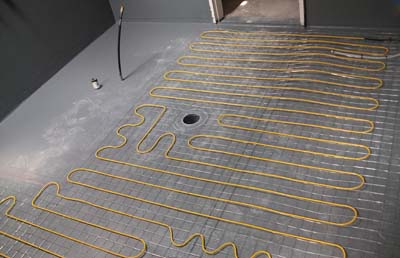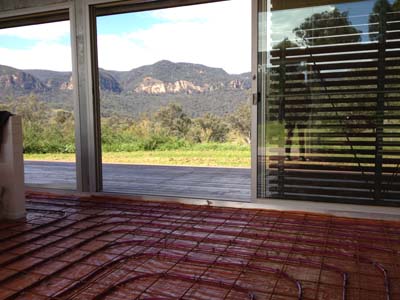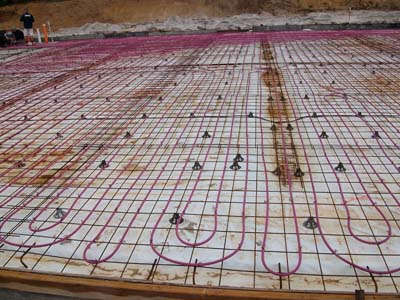Underfloor heating rapidly becoming the heating option of choice in both new housing developments and when undertaking major renovations
The advantages of underfloor heating are:
- Even heat distribution throughout the room
- It works at lower temperatures
- Invisibility
- No drafts
- Low maintenance
- Works with a wide range of energy sources
DIY kits
DIY kits include materials, installation instructions and schematics. Below are a few points to consider before deciding which kit is best for you.
Below: Examples electric underfloor heating systems



Underfloor heating rapidly becoming the heating option of choice in both new housing developments and when undertaking major renovations
Electric versus hydronic underfloor heating
Electric floor heating is probably the easiest option for those who wish to DIY. It is usually laid under tiles or hard surfaces in smaller areas (under 50 square metres). Bathrooms and kitchens are ideal for this product.
For larger total floor areas, hydronic becomes a cost effective option. Hydronic heating is heated water which flows through pipes laid into the floor. Water is heated with a boiler or other heat source. The benefit of this system is that electricity is not the only energy source you can use. Natural gas, heat pumps, geothermal, solar collectors and wood fired boilers are all options.
Off-the-shelf versus custom designed underfloor heating kits
Kits can be sold either ‘off-the-shelf’, or professional floor heating companies can design from individual floor plans, so they are custom made for the project.
Kits bought off-the-shelf can be an effective solution for a project if it falls in the lower end of the floor area the kit is designed for. If your project is in the upper floor area there may not be enough heating on the floor to effectively heat the floor during operation.
Custom designed kits are not much more expensive, but the benefits can be far greater. The kit will include an installation drawing designed from the floor plans, there will be specific installation instructions and there will be help from the floor heating company if required. Moreover, the amount of cable or pipe in the kit will be designed to ensure an effective heating system when operational.
Choosing the right heating system for your floor type
Most floor heating products are designed for specific types of floor coverings. There are many different floor heating systems, for example: under tile in a 20mm sand and cement bed, under tile in the tile glue, in the slab, under carpet and under timber. It is important to choose the right product for the installation.
Controlling the temperature of your underfloor heating
Most floor heating systems are connected directly to the domestic power supply via a thermostat. The thermostat will control the temperature of the floor. However, there are different types of thermostats. Floor sensing thermostats measure the temperature of the floor so it can be kept at the right temperature when operational. Usually this is around 25 degrees C. Some thermostats only have a room sensor, which means the thermostat needs to be in the same location as the floor it is measuring. Location of the thermostat is important so that the temperature of the room reflects the temperature of the floor. If it does not there is a chance the floor will overheat the room. Thermostats are now available with both floor and room sensors. This is ideal to manage the temperature of a room, so energy is not wasted heating a room which is already warm or if the floor is already at the set temperature.
More tips…
- Ensure the warranty on the DIY kit is the same as if the heating was installed professionally
- The cable used for the kit is a twin conductor cable as this will be easier to install
- The seller of the kit will provide assistance if required or the cable becomes damaged for any reason
- Floor plans or an accurate sketch of the area to be heated will ensure the floor area to be heated will be accurate and the right products are provided
- Licensed electricians and plumbers will be required to rough in for the electrical work and for hydronic systems. This ensures the energy and water supply is correctly connected, which will avoid future problems. Appropriate tradespeople should be consulted early in the project to prepare for the floor heating system.
If you do your homework there is no reason why a DIY floor heating system will be any different from a system installed by a professional.







